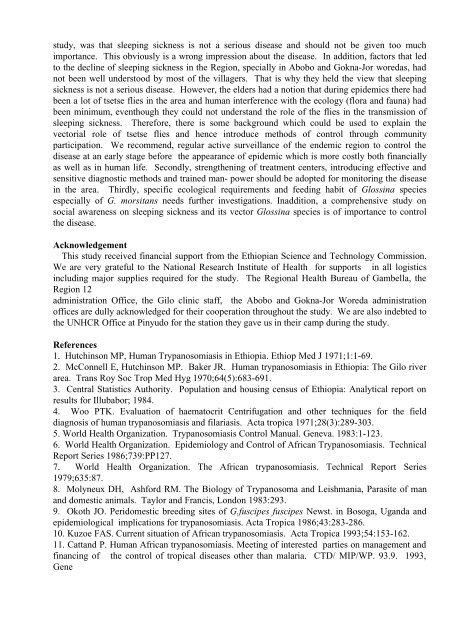Original article - Ethiopian Review
Original article - Ethiopian Review
Original article - Ethiopian Review
- No tags were found...
Create successful ePaper yourself
Turn your PDF publications into a flip-book with our unique Google optimized e-Paper software.
study, was that sleeping sickness is not a serious disease and should not be given too muchimportance. This obviously is a wrong impression about the disease. In addition, factors that ledto the decline of sleeping sickness in the Region, specially in Abobo and Gokna-Jor woredas, hadnot been well understood by most of the villagers. That is why they held the view that sleepingsickness is not a serious disease. However, the elders had a notion that during epidemics there hadbeen a lot of tsetse flies in the area and human interference with the ecology (flora and fauna) hadbeen minimum, eventhough they could not understand the role of the flies in the transmission ofsleeping sickness. Therefore, there is some background which could be used to explain thevectorial role of tsetse flies and hence introduce methods of control through communityparticipation. We recommend, regular active surveillance of the endemic region to control thedisease at an early stage before the appearance of epidemic which is more costly both financiallyas well as in human life. Secondly, strengthening of treatment centers, introducing effective andsensitive diagnostic methods and trained man- power should be adopted for monitoring the diseasein the area. Thirdly, specific ecological requirements and feeding habit of Glossina speciesespecially of G. morsitans needs further investigations. Inaddition, a comprehensive study onsocial awareness on sleeping sickness and its vector Glossina species is of importance to controlthe disease.AcknowledgementThis study received financial support from the <strong>Ethiopian</strong> Science and Technology Commission.We are very grateful to the National Research Institute of Health for supports in all logisticsincluding major supplies required for the study. The Regional Health Bureau of Gambella, theRegion 12administration Office, the Gilo clinic staff, the Abobo and Gokna-Jor Woreda administrationoffices are dully acknowledged for their cooperation throughout the study. We are also indebted tothe UNHCR Office at Pinyudo for the station they gave us in their camp during the study.References1. Hutchinson MP, Human Trypanosomiasis in Ethiopia. Ethiop Med J 1971;1:1-69.2. McConnell E, Hutchinson MP. Baker JR. Human trypanosomiasis in Ethiopia: The Gilo riverarea. Trans Roy Soc Trop Med Hyg 1970;64(5):683-691.3. Central Statistics Authority. Population and housing census of Ethiopia: Analytical report onresults for Illubabor; 1984.4. Woo PTK. Evaluation of haematocrit Centrifugation and other techniques for the fielddiagnosis of human trypanosomiasis and filariasis. Acta tropica 1971;28(3):289-303.5. World Health Organization. Trypanosomiasis Control Manual. Geneva. 1983:1-123.6. World Health Organization. Epidemiology and Control of African Trypanosomiasis. TechnicalReport Series 1986;739:PP127.7. World Health Organization. The African trypanosomiasis. Technical Report Series1979;635:87.8. Molyneux DH, Ashford RM. The Biology of Trypanosoma and Leishmania, Parasite of manand domestic animals. Taylor and Francis, London 1983:293.9. Okoth JO. Peridomestic breeding sites of G.fuscipes fuscipes Newst. in Bosoga, Uganda andepidemiological implications for trypanosomiasis. Acta Tropica 1986;43:283-286.10. Kuzoe FAS. Current situation of African trypanosomiasis. Acta Tropica 1993;54:153-162.11. Cattand P. Human African trypanosomiasis. Meeting of interested parties on management andfinancing of the control of tropical diseases other than malaria. CTD/ MIP/WP. 93.9. 1993,Gene




![to read the full report [pdf, Amharic] - Ethiopian Review](https://img.yumpu.com/52737829/1/190x245/to-read-the-full-report-pdf-amharic-ethiopian-review.jpg?quality=85)











